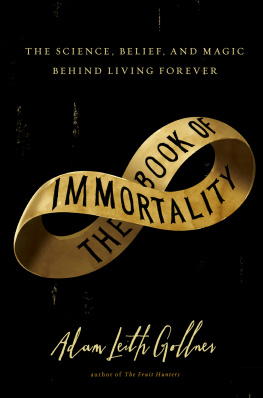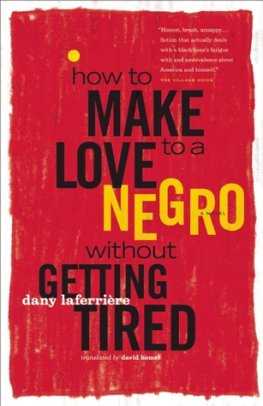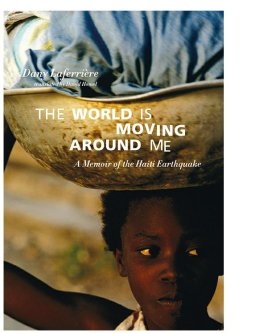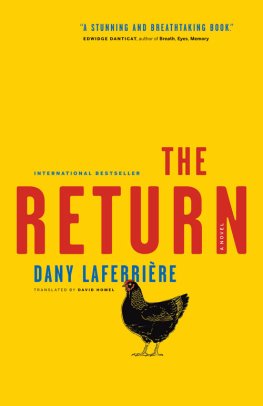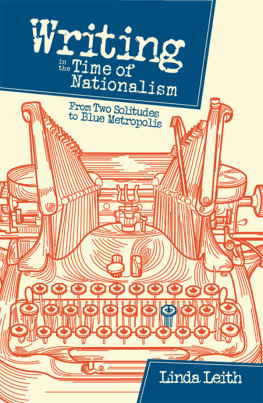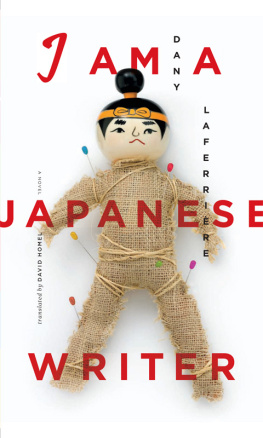Contents
Guide

Working in the Bathtub
Conversations with the Immortal Dany Laferrire

Copyright 2020, Adam Leith Gollner
Portions of these conversations were previously published by The Paris Review , Fall 2017. Copyright 2017, The Paris Review .
Illustrations copyright 2020, Laura L. Taylor.
All rights reserved. No part of this book may be reproduced, for any reason or by any means, without permission in writing from the publisher.
Cover design by Debbie Geltner
Book design by Tika eBooks
Proofreading by Jennifer McMorran
Cover photo copyright La Tribune / Jessica Garneau.
Author photo copyright Michael James OBrien.
Printed and bound in Canada.
Library and Archives Canada Cataloguing in Publication
Title: Working in the bathtub : conversations with the immortal Dany Laferrire / by Adam Leith Gollner.
Names: Gollner, Adam, 1976- author, interviewer. | Laferrire, Dany, interviewee.
Identifiers: Canadiana (print) 20200210424 | Canadiana (ebook) 20200210467 | ISBN 9781773900735 (softcover) | ISBN 9781773900742 (EPUB) | ISBN 9781773900759 (Kindle) | ISBN 9781773900766 (PDF)
Subjects: LCSH: Laferrire, DanyInterviews. | CSH: Authors, Canadian (French)Interviews. | LCGFT: Interviews.
Classification: LCC PS8573.A348 Z643 2020 | DDC C843/.54dc23
The publisher gratefully acknowledges the support of the Government of Canada through the Canada Council for the Arts, the Canada Book Fund, and Livres Canada Books, and of the Government of Quebec through the Socit de dveloppement des entreprises culturelles (SODEC).

Linda Leith Publishing
Montreal
www.lindaleith.com
nimporte ce qui valut
Le blanc souci de notre toile.
Stphane Mallarm, Salut
Table of Contents
INTRODUCTION:
THE STORY OF EVERYONE EVERYWHERE
INTRODUCTION THE STORY OF EVERYONE EVERYWHERE

Dany Laferrire was born in Port-au-Prince in 1953. His father, a former mayor of the city, was forced into exile by Franois Papa Doc Duvalier in 1959. For the next five years, young Dany lived with his grandmother Da in the coastal village of Petit-Gove, where his aunt Rene was the local librarian. Then, when the time came for middle school, he returned to the capital and his mother, who worked as an archivist for City Hall. He eventually became a culture reporter at Le Nouvelliste, Le Petit samedi soir, and Radio Haiti-Inter. At the age of 23, after the assassination of his best friend and close colleague, journalist Gasner Raymond, he fled the country.
Laferrire arrived in Montreal as the 1976 Olympics were getting underway. He found a way to survive on odd jobs (some very odd) and began writing fiction while living in the citys Quartier Latin. His first book, set in carr Saint-Louis during the sticky heat of summertime, was How to Make Love to a Negro Without Getting Tired (1985). An immediate success, it established a penchant for memorable titles. And like many of his subsequent works, the book tells the story of a writer writing a story that ends up being the book the reader is reading.
From 1990 until 2002, Laferrire and his family resided in Miami, where he completed ten books. Moving back to Montreal, he reached his widest audience with his 18th novel, The Return (2009), winner of the Prix Mdicis. Written in a mixture of verse and prose, its ostensibly about a son returning his deceased fathers remains to the Haitian homeland theyve both been exiled from. Beyond the subject matter, it, too, belongs to the same singular category that all his books fit into. Each is about a period in his life; each touches on and connects to other periods and other books; and each seems to constantly be on the verge of becoming something else altogether, the sculptural facade not simply cracking apart but the powder of its marble core drifting gently along a breeze into some ululating sunset. Most of the books are, at the same time, about writing and reading and art.
His oeuvre, presently over 30 volumes, is one long interconnected book about his writing of that book. He calls the entirety of his collection An American Autobiography. I like it when things dont have a beginning or an end, he says, in what could pass for a mission statement. Theres something Proustian and Faulkneresque about this endeavour, but Laferrires Caribbean-Qubcois Yoknapatawpha perdu is as postmodern as it is electrifying.
Some of his books are more about Haiti: Down Among the Dead Men (1997), Le cri des oiseaux fous (The Cry of Mad Birds, 2000), The World is Moving Around Me (2013). These centre on his family home, on childhood and adolescence, on life under a dictatorship, on the realities of life in Haiti today. Others are, to a greater extent, Montreal-based: A Drifting Year (1994), Eroshima (1987), and that sensational debut, How to Make Love to a Negro Without Getting Tired. A number of his texts bind Haiti to Montreal, the harshness of a snowbound northern island blending into the sunny noise of the tropics, where night becomes a Chagall painting.
He has also written several genre-confounding books that could be classified as un-self-help. His essay collection Lart presque perdu de ne rien faire (The Almost Forgotten Art of Doing Nothing, 2011) is, he explains, an autobiography of his emotions. (Then again, he has said the same thing about all of his other books.) A recent work, Tout ce quon ne te dira pas, Mongo (Everything They Wont Tell You, Mongo, 2015), is a kind of guidebook for newly arrived immigrants to the first world. The author of three childrens books and three illustrated novels, he has additionally been a screenwriter (2005s Heading South stars Charlotte Rampling) and directed a film, How to Conquer America in One Night (2004). I think you can do many things as a writer, so I do, he says.
His delightful Journal dun crivain en pyjama (Journal of a Writer in Pyjamas, 2013) consists of 202 short instructional passages on being an author. What does he say it takes to write a novel? A sturdy pair of buttocks; three years of anguish; a few days of partying; plus the ability to change into a plant or a stone. What else? A writer should live in a city they dont like, so they can write all day without feeling like they are missing out on anything. A writer should be a sorcerer who spills their spells, a trapeze acrobat who doesnt freak the audience out too much, a bongo player who lives to play the bongos. A writer should inject a short sentence between longer ones, for rhythm. A writer should focus on immortal themes: ideally love, or death, but in a sly way, as though withholding a secret.
Laferrire is currently a sitting member of the Acadmie Franaise, the highest honour a francophone writer can receive after the Nobel Prize. Members of the Acadmie are known as the immortals. Following tradition, he inherited his chair from previous members; fauteuil number two was held in the past by the likes of Montesquieu (1689-1755) and Alexandre Dumas fils


